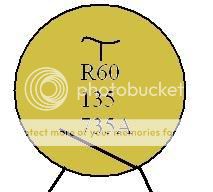Hey guys, im hoping someone can help me out with figuring out the exact capacitor that is in an Alpine Type-R crossover network(the speaker set is SPR-17s).
Something fell on the crossover network board and broke it in half. I just need 2 capacitors; luckly the inductors are fine (well, the 0.2mH inductor is relitively fine, i might just replace it though but it works for now).
the first capacitor is the Bennic XPP 3.3uF 5%, 160VAC/250VDC which i see is about $2-$4 through some websites.
The other one i cant figure out. It looks like a circular ceramic type but it seems to have a yellow/orange type plastic jacket.
The capacitor looks like this :

Thank you for your help!
Something fell on the crossover network board and broke it in half. I just need 2 capacitors; luckly the inductors are fine (well, the 0.2mH inductor is relitively fine, i might just replace it though but it works for now).
the first capacitor is the Bennic XPP 3.3uF 5%, 160VAC/250VDC which i see is about $2-$4 through some websites.
The other one i cant figure out. It looks like a circular ceramic type but it seems to have a yellow/orange type plastic jacket.
The capacitor looks like this :

Thank you for your help!
Are you sure it's a cap and not an MOV or other protection device?
135 = 1.3uF (=1300000pF) not a standard value, neither is 7.3uF
very fishy
135 = 1.3uF (=1300000pF) not a standard value, neither is 7.3uF
very fishy
This part is a PTC thermistor wired in series with the tweeter to protect it from overload. There is little that can be done to find out the actual type and manufacturer because some letters are almost always missing from the code written on the part.
You can just bypass them unless you are planning to use the system at high volumes.
You can just bypass them unless you are planning to use the system at high volumes.
Assuming it's a PTC thremistor, you can probably find a way to identify its rated value on the net, by measuring its resistance at some defined temperature, or go without its protection and replace it with a resistor the same value as it measures at room temperature, presumably something very low. Don't forget to subtract the resistance of the test leads.
You can use an automotive turn signal lamp, or the "tweeter protector" bulbs that look like fuses to replace these. Light bulbs are, in fact, PTC thermistors with about the right 'cold' resistance for the application.
look up a device called "polyswitch", "multifuse", "resettable fuse" or "PTC thermal fuse".
usually what goes wrong with them is a sound man thinks the system is losing highs,after his hearing numbs. so he turns up the highs, then the resettable fuses trip into high resistance mode, so the sound man cranks up the highs again, which after a while fries the resettable fuse (burns it open).
usually what goes wrong with them is a sound man thinks the system is losing highs,after his hearing numbs. so he turns up the highs, then the resettable fuses trip into high resistance mode, so the sound man cranks up the highs again, which after a while fries the resettable fuse (burns it open).
Eva & Pikefish are right.
If you can measure the room temp resistance of the good one in the other speaker you could probably find a similar device. If you wanted to get really fancy, you could also measure it in a pan of boiling water. With those two data points you could get a very close match.
Digikey is out of stock of PTC thermistors but you could substitute one of these:
http://www.alliedelec.com/Images/Products/Datasheets/BM/BOURNS/BOURNS_POWER-PRODUCTS_7541350.PDF
If you can measure the room temp resistance of the good one in the other speaker you could probably find a similar device. If you wanted to get really fancy, you could also measure it in a pan of boiling water. With those two data points you could get a very close match.
Digikey is out of stock of PTC thermistors but you could substitute one of these:
http://www.alliedelec.com/Images/Products/Datasheets/BM/BOURNS/BOURNS_POWER-PRODUCTS_7541350.PDF
wow thank you guys so much for the information!
I will look what you guys suggested, i hadn't dealt with this type of component but it looked exactly like a capacitor to me. I learn something new every day!
I could probably go without it because i never turn my speakers up very high at all but i will do my best to find a piece to replace it.
Thanks again! ill try to post if i am successful. I just dont want to purchase another crossover from Alpine, it would be expensive
I will look what you guys suggested, i hadn't dealt with this type of component but it looked exactly like a capacitor to me. I learn something new every day!
I could probably go without it because i never turn my speakers up very high at all but i will do my best to find a piece to replace it.
Thanks again! ill try to post if i am successful. I just dont want to purchase another crossover from Alpine, it would be expensive
- Status
- Not open for further replies.
- Home
- Amplifiers
- Solid State
- Can anyone help me ID this capacitor in crossover?